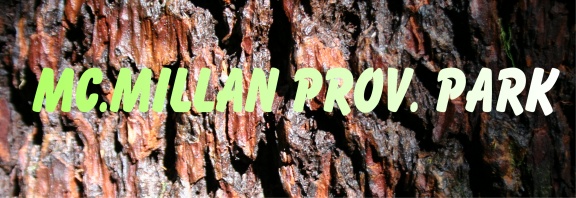West in Canada
 |
| View from Mt.Maxwell, Salt Spring Island |
 |
| On the ferry from Salt Spring Island to Crofton |
 MacMillan Provincial Park on Vancouver Island is famous for Cathedral Grove, one of the most accessible stands of giant Douglas-fir trees in British Columbia. A stroll on the network of trails meandering through the towering ancient Douglas-firs, some of which are more than 800 years old, can be quite an inspirational experience.
MacMillan Provincial Park on Vancouver Island is famous for Cathedral Grove, one of the most accessible stands of giant Douglas-fir trees in British Columbia. A stroll on the network of trails meandering through the towering ancient Douglas-firs, some of which are more than 800 years old, can be quite an inspirational experience. 

This wondrous display of Douglas-fir, Western Hemlock, Grand fir and Western Red Cedar has been undergoing the restoration of its trails since a severe windstorm damaged several sections of the park in January 1997.
Although visitors will now find many of these huge trees lying on the ground, their value has not diminished. These fallen trees open the canopy to provide light, space, shelter and nutrients for the next generations of plants. Natural regeneration is beginning to restore the Cathedral Grove's pristine beauty, and the park's diversity, making a visit to Cathedral Grove all the more intriguing.
Protests by environmental group have unfortunately failed to stop logging companies clear-cutting trees right up to the park boundary, thereby threatening the park ecosystem and destroying the wind barrier so necessary to prevent future blowdowns.
In restoring the trails, sections of some fallen trees were removed, offering a close-up opportunity for the curious to count the annual rings. Determine their age for yourself! Many species of wildlife use the old-growth forest as their home, including several types of woodpeckers, owls, insects, reptiles, amphibians, deer, elk, black bear and cougar. The Cameron River, which flows through the park, contains rainbow, brown and cutthroat trout.
The well-known forester, H.R. MacMillan, donated the 136 hectares of land in 1944 for the perpetual enjoyment of the public in recognition of the unique stand of trees. The area was established as a provincial park three years later, and expanded in size in the spring of 2005.
Park facilities are limited to pit toilets located on either side of Hwy #4, next to the parking lot. Once you have had your fill of these wonderful trees, you can swim or fish in Cameron Lake, picnic along its shores or hike to neighbouring Little Qualicum Falls Park.

The 157-hectare MacMillan Provincial Park is located on both sides of the Tofino Highway 4 on the shores of Cameron Lake, 19 miles (30 km) west of Parksville and 10 miles (16 km) east of Port Alberni on Vancouver Island, British Columbia. In case you want to go there...:-))




No comments:
Post a Comment
We like to hear from you. You can add your comment here: